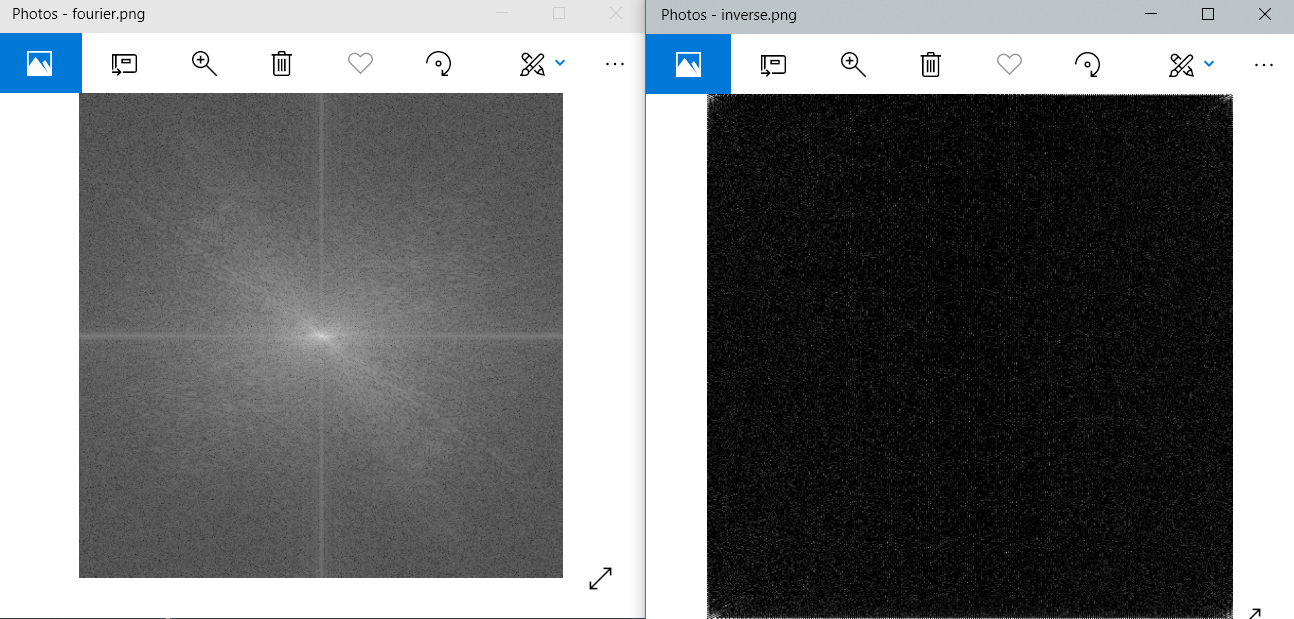Inverse fourier result is black and full of white dots
Hello all !
i am trying to learn about fourier transform , unfortunately i found problem when i'm trying to inverse the fourier output , here's the result i achieved

function fourier(src){
// get optimal size of DFT
let optimalRows = cv.getOptimalDFTSize(src.rows);
let optimalCols = cv.getOptimalDFTSize(src.cols);
let s0 = cv.Scalar.all(0);
let padded = new cv.Mat();
cv.copyMakeBorder(src, padded, 0, optimalRows - src.rows, 0,
optimalCols - src.cols, cv.BORDER_CONSTANT, s0);
// use cv.MatVector to distribute space for real part and imaginary part
let plane0 = new cv.Mat();
padded.convertTo(plane0, cv.CV_32F);
let planes = new cv.MatVector();
let complexI = new cv.Mat();
let plane1 = new cv.Mat.zeros(padded.rows, padded.cols, cv.CV_32F);
planes.push_back(plane0);
planes.push_back(plane1);
cv.merge(planes, complexI);
// in-place dft transform
cv.dft(complexI, complexI);
// compute log(1 + sqrt(Re(DFT(img))**2 + Im(DFT(img))**2))
cv.split(complexI, planes);
cv.magnitude(planes.get(0), planes.get(1), planes.get(0));
let mag = planes.get(0);
let m1 = new cv.Mat.ones(mag.rows, mag.cols, mag.type());
cv.add(mag, m1, mag);
cv.log(mag, mag);
// crop the spectrum, if it has an odd number of rows or columns
let rect = new cv.Rect(0, 0, mag.cols & -2, mag.rows & -2);
mag = mag.roi(rect);
// rearrange the quadrants of Fourier image
// so that the origin is at the image center
let cx = mag.cols / 2;
let cy = mag.rows / 2;
let tmp = new cv.Mat();
let rect0 = new cv.Rect(0, 0, cx, cy);
let rect1 = new cv.Rect(cx, 0, cx, cy);
let rect2 = new cv.Rect(0, cy, cx, cy);
let rect3 = new cv.Rect(cx, cy, cx, cy);
let q0 = mag.roi(rect0);
let q1 = mag.roi(rect1);
let q2 = mag.roi(rect2);
let q3 = mag.roi(rect3);
// exchange 1 and 4 quadrants
q0.copyTo(tmp);
q3.copyTo(q0);
tmp.copyTo(q3);
// exchange 2 and 3 quadrants
q1.copyTo(tmp);
q2.copyTo(q1);
tmp.copyTo(q2);
// The pixel value of cv.CV_32S type image ranges from 0 to 1.
cv.normalize(mag, mag, 0, 1, cv.NORM_MINMAX);
cv.imshow('fourierTransform', mag);
//the inverse part
let inverseTransform = new cv.Mat();
cv.dft(mag,inverseTransform,cv.DFT_INVERSE|cv.DFT_REAL_OUTPUT);
let finalImage = new cv.Mat();
inverseTransform.convertTo(finalImage,cv.CV_8U); //converting back to final image ???
cv.imshow('fourierTransform', finalImage);
}
the fourier transform part code is from opencv fourier
and then i added the reverse function and convert it back to 8 bit image.
is there something i miss ?

imho, if you normalize the magnitude to [0..1], you need to upscale your CV_8U image to [0.255], like:
also, what was used as src image ?
oh, and let's hope, the mag images is CV_32F, not CV_32S, as in your comment ;)
the image was lenna image . oh it was just a typo , the type that i used is 32_CF as you can see in the code above. i tried upscale image to 255 , the result is more or less the same (black and white dots all over the image)
you can't use the mag image for an inverse dft (it's no more complex, and has undergone a lot of changes (mostly for visualization here) !)
you can try to invert the
complexIimage, if you do that, you'll get something like this back:This is interesting. Can someone please put a final code in an answer?
@sjhalayka -- the sample is only demonstrating some common operations in the time domain. there is no real "purpose" behind those